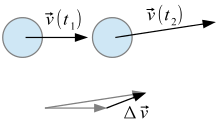Acceleration
![]()
This article describes the physical term. For the social science book, see Acceleration. The change of time structures in the modern age.
In physics, acceleration is the change in the state of motion of a body. As a physical quantity, acceleration is the instantaneous time rate of change of velocity. It is a vectorial, i.e. directed, quantity. Acceleration, along with location and velocity, is a central quantity in kinematics, a branch of mechanics.
In colloquial language, acceleration often refers only to an increase in "tempo", i.e. the amount of speed. In the physical sense, however, every change in a movement is an acceleration, e.g. also a decrease in the amount of speed - such as a braking process - or a pure change in direction with a constant amount of speed - such as when driving a car around a curve. In addition, there are terms in physics and technical mechanics such as centripetal acceleration or gravitational acceleration or similar, which are used to describe the acceleration that would occur in the movement of the body if only the force specified in the term were acting. Whether and how the body is actually accelerated, however, depends solely on the vector sum of all forces acting on it.
The SI unit of acceleration is m/s2. At an acceleration of 1 m/s2, the velocity changes by 1 m/s per second. In the geosciences, the unit Gal is also commonly used for 0.01 m/s2.
Accelerations occur in all real movement processes, e.g. of vehicles, aircraft or lifts. Due to the inertial force that occurs with them, they have a more or less significant effect on transported people and objects.
For circular movements, the angular acceleration is defined analogously as the change in angular velocity, i.e. the second time derivative of an angle.
Calculation
See also: Linear motion
The acceleration 





For a constant acceleration that does not 

In order to calculate the acceleration for a specific point in time instead of for a time interval, one must go from the difference quotient to the differential quotient. The acceleration is then the first time derivative of the velocity with respect to time:
Since velocity is the derivative of location with respect to time, acceleration can also be 
The time derivative of the acceleration (i.e., the third derivative of the location vector with respect to time) is called jerk :
Examples of calculation via speed
A car is moving at time 




The speed has thus increased by an average of 2 m/s (i.e. by 7.2 km/h) per second.
A passenger car driving before the red light within Δ 


Unit of acceleration
The standard unit of measurement for specifying an acceleration is the unit meter per square second (m/s2), i.e. (m/s)/s. In general, loads on technical equipment or the specification of load limits can be expressed as g-force, i.e. as "force per mass". This is given as a multiple of the normal acceleration due to gravity (standard acceleration due to gravity) g = 9.80665 m/s2. In the geosciences, the unit Gal = 0.01 m/s2 is also commonly used.
Acceleration of motor vehicles
For motor vehicles, the achievable positive acceleration is used as an essential parameter for classifying the performance. An average value is usually given in the form "In ... seconds from 0 to 100 km/h" (also 60, 160 or 200 km/h).
Numerical example:
For the Tesla Model S (type: Performance), it is stated that acceleration from 0 to 100 km/h can be achieved in 2.5 seconds. This corresponds to an average acceleration value of


Geometric construction of the difference of velocity vectors
Acceleration measurement
In principle, there are two ways of measuring or specifying accelerations. The acceleration of an object can be considered kinematically with respect to a path (space curve). For this purpose, the instantaneous velocity is determined, and its rate of change is the acceleration. The other possibility is to use an accelerometer. This determines the inertial force with the aid of a test mass, from which the acceleration is then inferred with the aid of Newton's basic equation of mechanics.
Questions and Answers
Q: What is acceleration?
A: Acceleration is a measure of how fast velocity changes.
Q: How is acceleration measured?
A: Acceleration is the change of velocity divided by the change of time.
Q: What type of quantity is acceleration?
A: Acceleration is a vector, and therefore includes both a size and a direction.
Q: How is speed defined?
A: Speed is how fast you are moving, and is measured as distance traveled divided by time taken.
Q: What is the difference between speed and velocity?
A: Velocity is a vector quantity and refers to how quickly your position is changing and in what direction.
Q: What is displacement?
A: Displacement is how much your position has changed in what direction.
Q: What is jerk?
A: Jerk is the measurement of how fast acceleration changes.
Search within the encyclopedia





